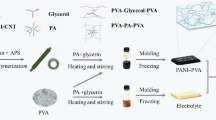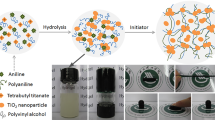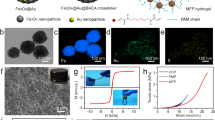Abstract
Herein, a conducting copolymer hydrogel of poly(aniline-co-pyrrole)/polyvinyl alcohol (PACP/PVA) was prepared by in-situ polymerization of aniline and pyrrole in aqueous solution of phytic acid and PVA. This PACP/PVA hydrogel can be used directly as self-standing electrode for supercapacitors. The hydrogel electrode delivers high electrochemical capacitance (633.5 F g−1 at 0.5 A g−1, 1267 mF cm−2 at 1 mA cm−2) and excellent cycling stability (86.4% capacitance retention after 10,000 cycles). In particular, the remarkable flexibility of the PACP/PVA hydrogel electrode is demonstrated by 81.7% of initial capacitance retention after repeated bending 500 cycles. Based on PACP/PVA hydrogel electrode and a typical PVA/H2SO4 hydrogel electrolyte, an all-hydrogel-state supercapacitor was assembled. The supercapacitor demonstrates high areal capacitance of 317 mF cm−2 at 1 mA cm−2 and energy density of 44 µWh cm−2 (22 Wh kg−1) at 250 µW cm−2 (125 W kg−1). This work provides a new direction for fabricating self-standing flexible hydrogel electrode materials for smart and wearable devices.
Graphical abstract








Similar content being viewed by others
References
Amjadi M, Kyung K-U, Park I, Sitti M (2016) Stretchable, skin-mountable, and wearable strain sensors and their potential applications: a review. Adv Funct Mater 26:1678–1698
El-Kady MF, Strong V, Dubin S, Kaner RB (2012) Laser scribing of high-performance and flexible graphene-based electrochemical capacitors. Science 335:1326–1330
Bonaccorso F, Colombo L, Yu G, Stoller M, Tozzini V, Ferrari AC, Ruoff RS, Pellegrini V (2015) Graphene, related two-dimensional crystals, and hybrid systems for energy conversion and storage. Science 347:1246501–1246509
Someya T, Bao Z, Malliaras GG (2016) The rise of plastic bioelectronics. Nature 540:379–385
Wang Y, Xia Y (2013) Recent progress in supercapacitors: from materials design to system construction. Adv Mater 25:5336–5342
Yang ZK, Ma J, Bai BR, Qiu AD (2019) Free-standing PEDOT/polyaniline conductive polymer hydrogel for flexible solid-state supercapacitors. Electrochim Acta 322:134769
Wang M, Yang J, Liu SY, Lia MZ, Hu C (2020) Nitrogen-doped hierarchically porous carbon nanosheets derived from polymer/graphene oxide hydrogels for high-performance supercapacitors. J Colloid Interface Sci 560:69–76
Yu L, Zhang G, Yuan C, Lou XW (2013) Hierarchical NiCo2O4@MnO2 core-shell heterostructured nanowire arrays on Ni foam as high-performance supercapacitor electrodes. Chem Commun 49:137–139
Yu GH, Hu LB, Vosgueritchian M, Wang HL, Xie X, McDonough JR, Cui X, Cui Y, Bao ZN (2011) Solution-processed graphene/MnO2 nanostructured textiles for high-performance electrochemical capacitors. Nano Lett 11:2905–2911
Wang B, Chen JS, Wang Z, Madhavi S, Lou XW (2012) Green synthesis of NiO nanobelts with exceptional pseudo-capacitive properties. Adv Energy Mater 2:1188–1192
Pumera M (2011) Graphene-based nanomaterials for energy storage. Energy Environ Sci 4:668–674
Bo JY, Luo XF, Huang HB, Lia L, Lai W (2018) Morphology-controlled fabrication of polypyrrole hydrogel for solid-state supercapacitor. J Power Sources 407:105–111
Wang ML, Yu YF, Cui MZ, Cao X, Liu WF (2020) Development of polyoxometalate-anchored 3D hybrid hydrogel for high-performance flexible pseudo-solid-state supercapacitor. Electrochim Acta 329:135181
Pan LJ, Yu GH, Zhai DY, Lee HR (2012) Hierarchical nanostructured conducting polymer hydrogel with high electrochemical activity. Proc Natl Acad Sci USA 109:9287–9292
Wang YQ, Shi Y, Pan LJ, Ding Y, Zhao Y (2015) Dopant-enabled supramolecular approach for controlled synthesis of nanostructured conductive polymer hydrogels. Nano Lett 15:7736–7741
Heydari H, Gholivand MB (2017) An all-solid-state asymmetric device based on a polyaniline hydrogel for a high energy flexible supercapacitor. New J Chem 41:237–244
Wang W, Zhang Q, Li J, Liu X, Wang L, Zhu J, Luo W, Jiang W (2015) An efficient thermoelectric material: preparation of reduced graphene oxide/polyaniline hybrid composites by cryogenic grinding. RSC Adv 5:12
Huang Y, Li HF, Wang ZF, Zhu MS, Pei ZX, Xue Q, Huang Y, Zhi CY (2016) Nanostructured polypyrrole as a flexible electrode material of supercapacitor. Nano Energy 22:422
Peng ZY, Wang CZ, Zhang ZC, Zhong WB (2019) Synthesis and enhancement of electroactive biomass/polypyrrole hydrogels for high performance flexible all-solid-state supercapacitors. Adv Mater Interfaces 6:1901393
Fu LJ, Qu QT, Holze R, Kondratiev V, Wu YP (2019) Composites of metal oxides and intrinsically conducting polymers as supercapacitor electrode materials: the best of both worlds? J Mater Chem A 7:25
Shi Y, Pan LJ, Liu BR, Wang YQ, Cui Y (2014) Nanostructured conductive polypyrrole hydrogels as high performance, flexible supercapacitor electrodes. J Mater Chem A 2:6086–6091
Huang HB, Yao JL, Li L, Zhu F, Liu ZT (2016) Reinforced polyaniline/polyvinyl alcohol conducting hydrogel from a freezing-thawing method as self supported electrode for supercapacitors. J Mater Sci 51:8728–8736. https://doi.org/10.1007/s10853-016-0137-8
Ding Q, Xu X, Yue Y, Mei C, Huang C (2018) Nanocellulose-mediated electroconductive self-healing hydrogels with high strength, plasticity, viscoelasticity, stretchability, and biocompatibility toward multifunctional applications. ACS Appl Mater Interfaces 10:27987–28002
Yin BS, Zhang SW, Ren QQ, Liu C (2017) Elastic soft hydrogel supercapacitor for energy storage. J Mater Chem A 5:24942
Wang M, Yang J, Liu SY, Li MZ (2020) Nitrogen-doped hierarchically porous carbon nanosheets derived from polymer/graphene oxide hydrogels for high-performance supercapacitors. J Colloid Interface Sci 560:69–76
Almeida AL, Ferreira NG (2020) Fabrication of binary composites from polyaniline deposits on carbon fibers heat treated at three different temperatures: structural and electrochemical analyses for potential application in supercapacitors. Mater Chem Phys 239:122101
Arthisree D, Madhuri W (2020) Optically active polymer nanocomposite composed of polyaniline, polyacrylonitrile and greensynthesized graphene quantum dot for supercapacitor application. Int J Hydrogen Energy 45:9317–9327
San B, Talu M (1998) Electrochemical copolymerization of pyrrole and aniline. Synth Met 94:221–227
Fusalba F, elanger DB´ (1999) Electropolymerization of polypyrrole and polyaniline-polypyrrole from organic acidic medium. J Phys Chem B 103:9044–9054
Cakmak G, Küçükyavuz Z, Küçükyavuz S (2005) Conductive copolymers of polyaniline, polypyrrole and poly (dimethylsiloxane). Synth Met 151:10–18
Moyseowicz A, González Z, Menéndez R, Gryglewicz G (2018) Three-dimensional poly(aniline-co-pyrrole)/thermally reduced graphene oxide composite as a binder-free electrode for high-performance supercapacitors. Compos B 145:232–239
Tran VC, Sahoo S, Hwang J, Nguyen VQ (2018) Poly(aniline-co-pyrrole)-spaced graphene aerogel for advanced supercapacitor electrodes. J Electroanal Chem 810:154–160
Zhang AQ, Wang LZ, Zhang LS, Zhang Y (2010) Preparation and electrochemical capacitance of poly(pyrrole-co-aniline). J Appl Polym Sci 115:1881–1885
Wang Y, Ma WB, Guo L, Song XZ, Tao XY (2020) Phytic acid-doped poly(aniline-co-pyrrole) copolymers for supercapacitor electrodes applications. J Mater Sci Mater Electron 31:6263–6273
Li L, Zhang Y, Lu HY, Wang YF, Xu JS, Zhu JX (2020) Cryopolymerization enables anisotropic polyaniline hybrid hydrogels with superelasticity and highly deformation-tolerant electrochemical energy storage. Nat Commun 11:62
Carli DC, Egon S, Massao I, Bruno S (2009) Thermoanalytical and spectroscopic studies to characterize phytic acid complexes with Mn(II) and Co(II). J Braz Chem Soc 20:1515–1522
Stejskala J, Trchov M (2004) Poly(aniline-co-pyrrole): powders, films, and colloids. Thermophoretic mobility of colloidal particles. Synth Met 146:29–36
Wang HX, Biswas SK, Zhu SL, Lu Y, Yue YY (2020) Self-healable electro-conductive hydrogels based on core-shell structured nanocellulose/carbon nanotubes hybrids for use as flexible supercapacitors. Nanomaterials 10:112
Pandey K, Yadav P, Indrajit M (2015) Elucidating the effect of copper as a redox additive and dopant on the performance of a PANI based supercapacitor. Phys Chem Chem Phys 17:878
Zang LM, Liu QF, Qiu JH, Yang C, Wei C (2017) Design and fabrication of an all-solid-state polymer supercapacitor with highly mechanical flexibility based on polypyrrole hydrogel. ACS Appl Mater Interfaces 9:33941–33947
Li WW, Lu H, Zhang N, Ma MM (2017) Enhancing the properties of conductive polymer hydrogels by freeze-thaw cycles for high-performance flexible supercapacitors. ACS Appl Mater Interfaces 9:20142–20149
Xu WB, Mu B, Zhang WB, Wang AQ (2016) Facile fabrication of well-defined polyaniline microtubes derived from natural kapok fibers for supercapacitors with long-term cycling stability. RSC Adv 6:68302
Guo YH, Bae J, Zhao F, Yu GH (2019) Functional hydrogels for next-generation batteries and supercapacitors. Trends chem 1:335–348
Hao GP, Hippauf F, Oschatz M, Wisser FM (2014) Stretchable and semitransparent conductive hybrid hydrogels for flexible supercapacitors. ACS Nano 8:7138–7146
Meng CZ, Liu CH, Chen LZ, Hu CH (2010) Highly flexible and all-solid-state paperlike polymer supercapacitors. Nano Lett 10:4025–4031
Hu RF, Zheng JP (2017) Preparation of high strain porous polyvinyl alcohol/polyaniline composite and its applications in all-solid-state supercapacitor. J Power Sources 364:200–207
Li WW, Gao FX, Wang XQ, Zhang N (2016) Strong and robust polyaniline-based supramolecular hydrogels for flexible supercapacitors. Angew Chem Int Ed 55:9196–9201
Acknowledgements
This research was supported by the Fundamental Research Funds for the Central Universities (Grant 2019XKQYMS03).
Author information
Authors and Affiliations
Contributions
XYT was involved in funding acquisition, writing-original draft, writing-review & editing, project administration. YW contributed to investigation, validation. WBM was involved in methodology. SFY contributed to writing-review & editing. KHZ was involved in data curation. LTG contributed to conceptualization. HLF was involved in software. ZSL contributed to formal analysis. YBZ was involved in supervision. XYW contributed to resources.
Corresponding author
Ethics declarations
Conflict of interest
The authors declare that they have no known competing financial interests or personal relationships that could have appeared to influence the work reported in this paper.
Additional information
Handling Editor: Maude Jimenez.
Publisher's Note
Springer Nature remains neutral with regard to jurisdictional claims in published maps and institutional affiliations.
Supplementary Information
Below is the link to the electronic supplementary material.
Rights and permissions
About this article
Cite this article
Tao, XY., Wang, Y., Ma, Wb. et al. Copolymer hydrogel as self-standing electrode for high performance all-hydrogel-state supercapacitor. J Mater Sci 56, 16028–16043 (2021). https://doi.org/10.1007/s10853-021-06304-3
Received:
Accepted:
Published:
Issue Date:
DOI: https://doi.org/10.1007/s10853-021-06304-3




